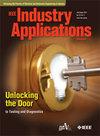Fast Finite Element Based Vibration Response Calculation Procedure for Permanent Magnet Synchronous Machines
IF 4.2
2区 工程技术
Q2 ENGINEERING, ELECTRICAL & ELECTRONIC
引用次数: 0
Abstract
The vibration of the stator frame due to electromagnetic forces is one of the main noise and vibration sources of electric machines. In some applications, due to the wide variety of working conditions, magnetic circuit design optimisations are not enough, and the control of the machine is needed to reduce vibrations. Therefore, this work presents a reduced model, to be used during the control, which is able to estimate the stator frame vibrations of a Permanent Magnet Synchronous Machine. Finite Element calculations are performed, and the results are saved in Look-Up Tables and implemented in a calculation procedure, allowing a fast vibration estimation for any input conditions. The proposed model demonstrated the same accuracy as Finite Element simulations, with a calculation time of several seconds. The model was validated using experimental measurements, and it reliably estimated the evolution of the vibration of a commercial machine under varying current and rotational speed. Its potential to test harmonic current injection strategies was also experimentally corroborated. Thus, the model presented in this work is suitable to be further developed and implemented as a virtual sensor in a harmonic injection control procedure.求助全文
约1分钟内获得全文
求助全文
来源期刊

IEEE Transactions on Industry Applications
工程技术-工程:电子与电气
CiteScore
9.90
自引率
9.10%
发文量
747
审稿时长
3.3 months
期刊介绍:
The scope of the IEEE Transactions on Industry Applications includes all scope items of the IEEE Industry Applications Society, that is, the advancement of the theory and practice of electrical and electronic engineering in the development, design, manufacture, and application of electrical systems, apparatus, devices, and controls to the processes and equipment of industry and commerce; the promotion of safe, reliable, and economic installations; industry leadership in energy conservation and environmental, health, and safety issues; the creation of voluntary engineering standards and recommended practices; and the professional development of its membership.
 求助内容:
求助内容: 应助结果提醒方式:
应助结果提醒方式:


